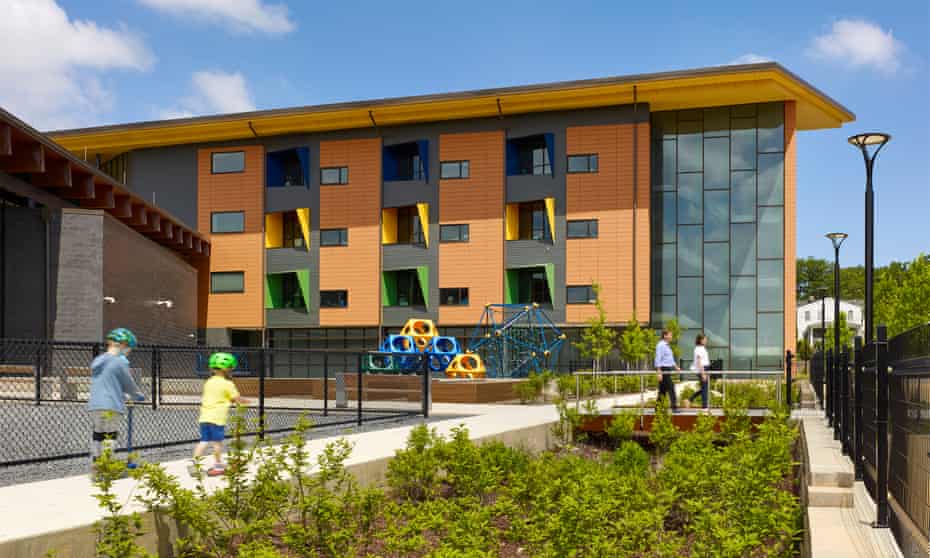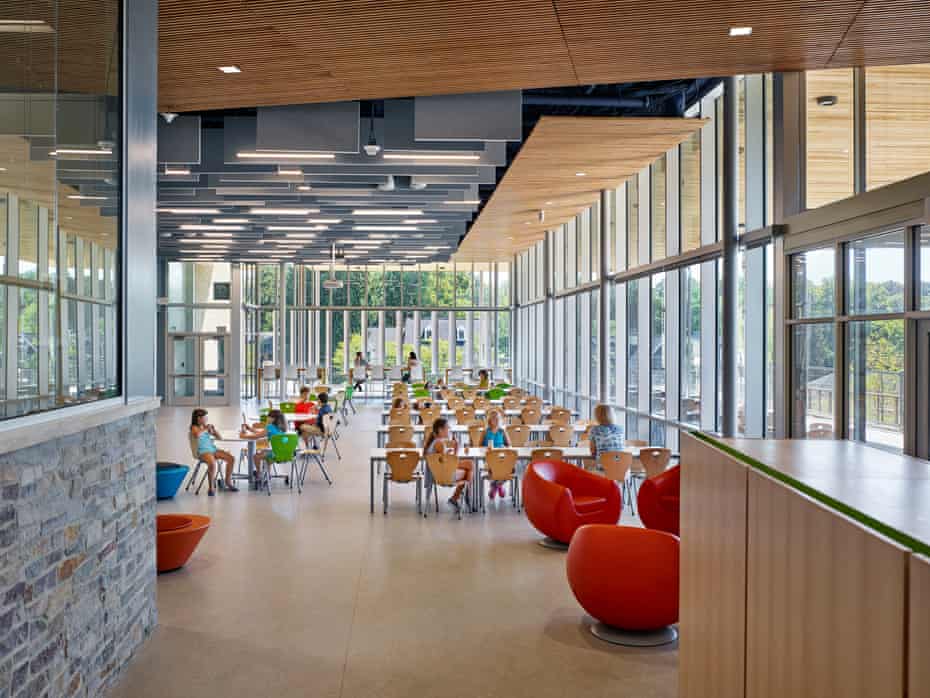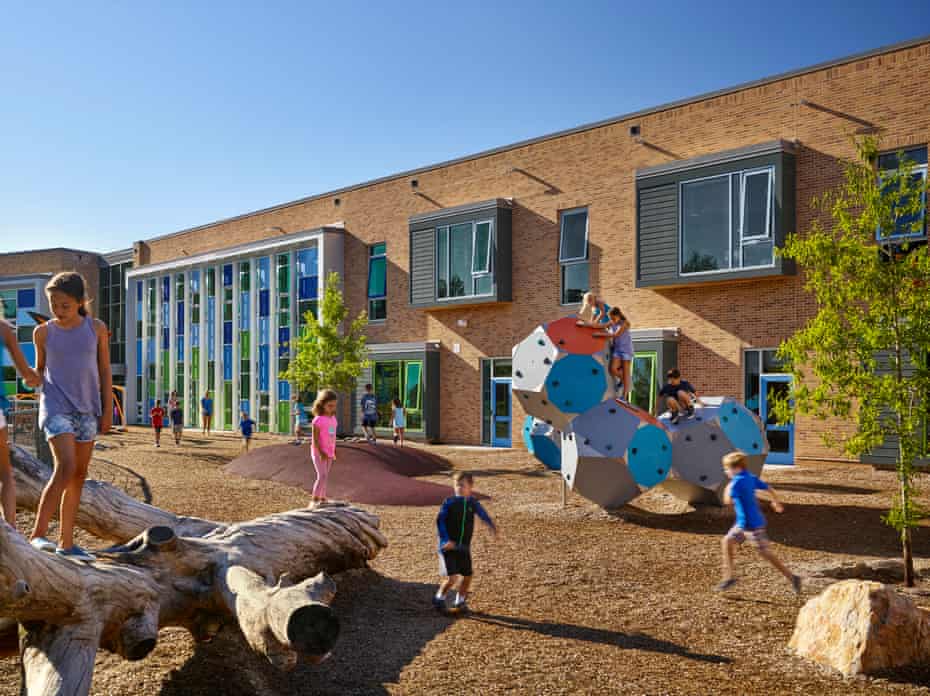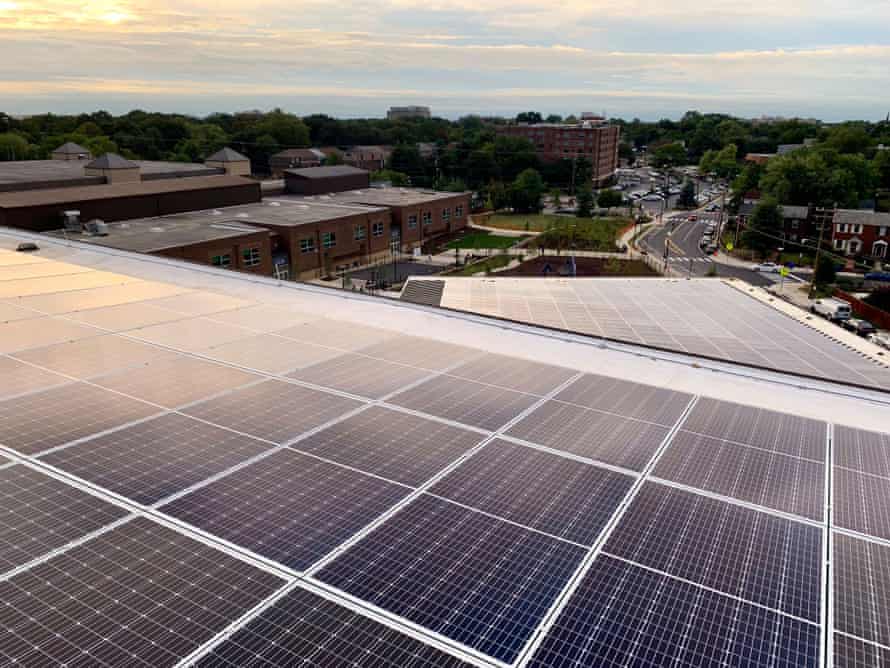The US public schools redesigning buildings with climate in mind

School districts are increasingly transitioning to cheaper and greener options. But old building habits and funding constraints can pose a challenge
American schools are the second-largest public infrastructure investment. But what most people don’t know is that they are also among the biggest energy consumers in the public sector. K-12 schools consume about 8% of all the energy used in commercial buildings. In turn, they emit as much carbon dioxide as 18 coal-powered power plants. This not only burdens the environment, but children themselves – students suffer from heatstroke, affected hormone and sleep cycles, as well as respiratory issues.
Many schools have started redesigning their infrastructure with the climate crisis in mind. From installing more solar panels to replacing old heating, cooling and ventilation systems, or HVAC systems, with more sustainable ones, school districts are increasingly transitioning to cheaper and greener options. But old building habits and funding constraints can pose a challenge.
In Maine, one school district has already started making drastic changes. The state’s district 24 is building the Charles M Sumner Learning campus, which will serve more than 500 students from grades six to nine. The 103,000 sq ft building will replace the existing 1950s-era Sumner Memorial high school and feature air-source heat pumps, along with energy recovery ventilation.
Arkansas’s Batesville school district, meanwhile, recently installed more than 1,500 solar panels, which now generate about half of the district’s electricity. Before the installations, the district spent over half a million dollars annually on utilities. The solar power changes are now saving the district over $300,000 annually, which is “going to continue to go back into our teachers’ salaries”, said Megan Renihan, the district’s communications coordinator.
Similarly, the Santa Barbara Unified school district has launched an ambitious initiative with the Clean Coalition to stage solar microgrids across its 18 school sites. One school, San Marcos high school, is located in the grid-constrained Goleta Load Pocket, an area with extreme fire risk. The solar microgrids will enable the school to operate independently during grid outages and offer indefinite resilience for the most critical loads, such as food service refrigerators and freezers.

To architects like Tony Hans, who worked on various zero-energy school projects including the nation’s first net-zero energy school, the best indicator of how energy-efficient a building is going to be is by evaluating how its design team performed when given the goal in the past.
“Understanding how that building performed, tracking those metrics, diving into a building after it’s been operational, then learning from that to do better … that creates this cycle of performance-based design,” said Hans, the national director of sustainable projects at consulting engineering firm CMTA.
“Most contractors, construction managers and architects believe it costs more to design a more sustainable and energy-efficient school. The truth is it takes more study, a more dedicated team, more iterations and focus on those specific goals,” he said, adding: “It doesn’t take higher construction costs. It takes a paradigm shift.”
In 2021, the American Society of Civil Engineers gave the country’s schools a D+ in their Report Card for America’s Infrastructure. The report found that 53% of public school districts need to update or replace various building systems.
“We know that from anecdotal evidence, the school buildings that were built between the 1950s and 1970s are some of the schools with the most issues,” said Anisa Heming, director of Center for Green Schools at the US Green Building Council.
In addition to asbestos, many schools were built with air conditioners that have single-pane windows, often resulting in substantial heat loss during winters. Moreover, many schools have lead soldering in pipes, which experts regard as the major cause of lead contamination of drinking water across the country.
As schools battle increasing heatwaves, many also lack the appropriate cooling mechanisms to continue operating. “When we talk about disruptions to our schools, being prepared for hot days is important. It’s not just thinking about singularly adding AC. We need to actually think about how to cool buildings more appropriately in a sustainable way,” said Laura Shifter, a senior fellow at the Aspen Institute’s K12 Climate Action initiative.
Numerous schoolyards across the country are made with heat-trapping asphalt, which in turn increases the heat on the playground and community. In an interview with Land and People Magazine, Ricardo Cortes, a parent of a kindergartener at Melrose Leadership Academy in East Oakland, described the effect of hot playground surfaces on his children.

“Our kids were coming home sunburned and dehydrated, even from just being out there for a short time at recess. They had headaches. We worried about heatstroke,” he said. As a result, some schools, including Melrose, have started to invest in green sustainable schoolyards, planting various plants and trees to create adequate shade.
In addition to heat, poor ventilation has also become a serious issue. More than 41% of schools reported problems with the HVAC systems, “a significant concern for facilities where children routinely spend eight hours a day”.
There are significant correlations between air quality and cognitive function among students. Experts have found that increased CO2 levels often result in reduced focus, sleepiness, headaches and increased asthmatic episodes in classrooms.
The pandemic has also exacerbated the need for better ventilation systems. Recommendations include “increased ventilation, better filtration, improved air distribution or use of other air cleaning or treatment technologies”.
Yet despite the recommendations, not all school districts are equipped to make the changes. In a national survey carried out by ASHRAE and the Center for Green Schools, the most cited challenge to implementation was that many schools were not designed to support the recommended strategies.
To address the $38bn annual funding gap for these inadequacies, Senator Jack Reed of Rhode Island introduced the Reopen and Rebuild America’s Schools Act in January. The act pledges to invest $130bn in public schools. Similarly, the Biden administration’s bipartisan infrastructure deal pledges $50bn in grants and $50bn in bonds for school building improvements, $45bn for eliminating the nation’s lead pipes, including those connected to schools, and $20bn for electrifying school buses.
“There are buildings that need to be maintained and retrofitted and so let’s start by never replacing a fossil fuel boiler with another fossil fuel boiler,” says Lisa Hoyos, the national climate strategy director at the League of Conservation Voters. “We need to think about what kind of changes to our physical infrastructure we need to make to make sure those changes don’t exacerbate the problem of climate change.”
In addition to mitigating emissions and decarbonizing existing schools, architects and sustainable engineering organizations are designing and building net-zero schools from scratch.

Wyck Knox, an architect at VMDO Architects, led the design of Discovery elementary school, the largest certified net-zero energy school in the country, which opened in 2015. The design team prioritised considerations for site footprint, solar orientation, building construction and energy.
The 97,588 sq ft building features insulated concrete exterior walls with high thermal mass, bioretention areas that clean and slowly release all of the water from the site, a geothermal well field which supplies heat at a consistent 118F (48.8C), low-flow plumbing fixtures that exceed the energy and water savings targets set by Arlington public schools, and 100% LED lighting. The school also features 1,706 roof-mounted solar panels which were purchased for less than the original budget.
“That was kind of the big breakthrough accomplishment that allowed the [Arlington] school district to say, ‘Why would we go back now that we’ve seen that we can get a school to generate all its own clean energy and then some, and put extra clean energy on to the grid for the original price?'” Knox said.
As a result, Knox’s next school project was designing Alice West Fleet elementary school, the second of three net-zero energy schools for Arlington public schools. Completed in 2019, the school contains energy-saving features such as optimum solar orientation. Multiple studies have found that schools with optimized daylight increase student performance as natural lighting regulates melatonin and reinforces circadian wellness.

In addition to optimized daylight, Alice West Fleet is equipped with high-performance HVAC systems and small individual heat pump units that provide the proper amount of conditioned air only when and where it is needed. The conditioned air is created by exchanging heat with the ground through 72 560ft deep wells underneath the school.
The third net-zero energy school, Cardinal elementary school, is set to open in September and will feature a stormwater detention vault to address flooding concerns after the area experienced a record-breaking and damaging deluge in July 2019.

Addressing the challenges surrounding these projects, Wyck said: “It’s really about balancing all the competing interests, particularly in urban and dense suburban areas,” adding: “It means having a broader conversation with more people … as resiliency requires comprehensive solutions.”
With many American schools undergoing sustainable transitions, they are becoming living laboratories for students as classrooms design educational assignments based on sustainable initiatives, such as calculating the amount of daylight a school building saves.
“It really isn’t just about building more sustainable schools, but also cultivating that sort of sustainable mindset in the schools,” Tony Hans said.